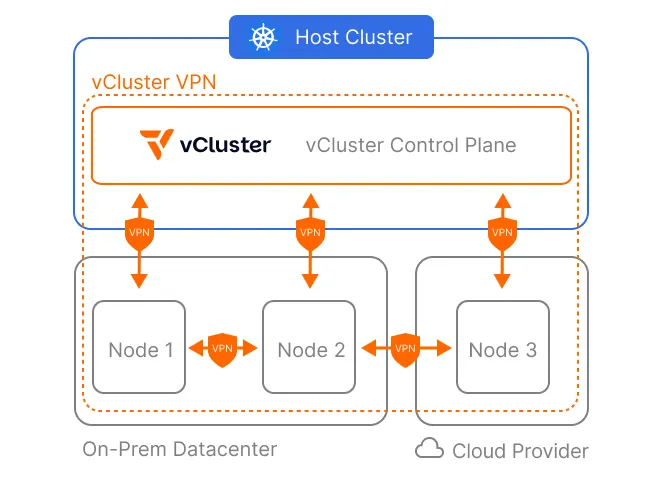Table of Contents
There comes a day when your steady-state capacity just isn’t enough. Maybe it’s a product launch that exceeds all expectations, a seasonal traffic surge, a viral ad campaign, or a massive machine learning retraining job. Whatever the trigger, your workloads suddenly outgrow your baseline infrastructure.
Cloud bursting is the safety valve for those moments. It’s the ability to keep your core workloads running on your private environment-or primary cloud-while seamlessly “bursting” the overflow to a secondary cloud for extra capacity. No re-architecture, no disruption, no panic.
This article provides a clear mental model of how cloud bursting works, explains its importance, and outlines a simple plan for implementing it, leveraging vCluster VPN from the latest vCluster v0.30 release. The new release emphasizes seamless multi-cloud Kubernetes networking, making your cross-cloud scaling effortless and secure.
What’s Cloud Bursting?
Cloud bursting is the practice of temporarily shifting workloads from a private or primary cloud to a public or secondary cloud to manage overflow capacity. It demonstrates elastic infrastructure by scaling up when needed and scaling back down when not. The main benefit is improved efficiency.
Instead of overprovisioning resources throughout the year to accommodate rare traffic spikes, you can size your steady-state environment for normal operations and burst only when necessary. This results in lower baseline costs, quicker response to demand surges, and higher overall utilization.
Especially useful in scenarios like large-scale data processing, seasonal retail traffic, media rendering, or any unpredictable compute spike. It serves as your operational buffer, allowing your infrastructure to expand without long-term commitments, with the most common burst patterns being:
Scale-out burst: Add extra worker nodes in the secondary cloud while keeping the control plane and core services local. Ideal for compute-heavy workloads like batch jobs or analytics.
Split-tier burst: Offload stateless tiers (like frontend or caching layers) to the public cloud while keeping stateful services (like databases) within your private cluster.
Follow-the-sun burst: Dynamically shift workloads between regions or clouds based on user activity or time zones to maintain low latency and cost efficiency.

Why it Matters
Cloud bursting allows you to run efficiently without losing responsiveness. Instead of permanently scaling your infrastructure for peak demand, you can size it for normal operations and use public cloud flexibility when unexpected demands arise. This results in significant cost savings-resources are used only when traffic spikes, while performance stays smooth and reliable for users. It strikes a smart balance between operational efficiency and business agility.
Beyond saving costs, cloud bursting broadens your technical capabilities. You can quickly access specialized compute resources, such as GPUs or high-memory nodes from any cloud provider, without needing to overhaul your existing setup. For instance, with vCluster Private Nodes, you can attach a worker node from a different vendor directly into your control plane, enabling you to use diverse hardware or pricing options on demand. This flexibility allows teams to run demanding workloads or adjust to new business priorities in minutes.
Your Simple Bursting Strategy
When running hybrid or on-prem environments, networking is often the hardest part of scaling. Private clusters typically keep their control planes isolated from the public internet, but nodes need to connect back somehow—usually through LoadBalancers, Ingress controllers, or static routes. That works if everything lives on the same physical network, but becomes fragile and complex the moment you add cloud or remote resources.
vCluster VPN eliminates that complexity.

vCluster VPN: The Secure Bridge
vCluster VPN creates a secure, encrypted overlay network between the virtual cluster control plane and its nodes using the networking technology that is developed by Tailscale. This means:
No control plane exposure — nodes connect privately, no LoadBalancer or public endpoint needed.
Consistent connectivity — control plane ↔ node and node ↔ node communication works seamlessly across data centers, clouds, or local machines.
Automatic isolation — each virtual cluster operates in its own VPN network segment, ensuring strict separation and secure communication between clusters.
The result is a fully private, self-contained network fabric for your virtual clusters—ready to span any environment without manual tunneling, firewall edits, or static IP management.
Private & Auto Nodes: Minimal Bursting Made Simple
Once vCluster VPN is in place, Private Nodes can run inside your own network or data center—securely connected to the control plane without ever opening ports. When your workloads spike, Auto Nodes powered by Karpenter can instantly join from any cloud or local provider. Both node types use the same encrypted overlay network, so the control plane doesn’t care where they come from.
That’s your minimal bursting strategy:
Baseline: Run steady-state capacity on Private Nodes (on-prem, edge, or internal).
Burst: Let Auto Nodes spin up in the cloud when resource demand exceeds capacity.
Network: Rely on vCluster VPN to unify all nodes—private or cloud—into a single, secure virtual network.
With this setup, you can burst elastically into any environment while maintaining private, low-latency connectivity between your control plane and all workloads.
Easy to Enable Setup
Let’s walk through setting up a burst-to-cloud virtual cluster — a hybrid setup where your baseline runs on-prem and extra capacity comes from the cloud.
Step 1: Create NodeProviders
Start by creating NodeProviders for your private infrastructure (e.g., OpenStack) and a cloud provider like AWS. These define how vCluster provisions and manages nodes in each environment.
Step 2: Deploy a Virtual Cluster with vCluster VPN
With both providers ready, create a virtual cluster using two node pools and enable vCluster VPN for secure, cross-environment networking:
# vcluster.yaml
privateNodes:
enabled: true
# Expose the control plane privately to nodes using vCluster VPN
vpn:
enabled: true
# Create an overlay network over all nodes in addition to direct control plane communication
nodeToNode:
enabled: true
autoNodes:
- provider: openstack
static:
# Ensure we always have at least 10 large on-prem nodes in our cluster
- name: on-prem-nodepool
quantity: 10
nodeTypeSelector:
- property: instance-type
value: "lg"
- provider: aws
# Dynamically join ec2 instances when workloads exceed our on-prem capacity
dynamic:
- name: cloud-nodepool
nodeTypeSelector:
- property: instance-type
value: "t3.xlarge"
limits:
nodes: 20 # Enforce a maximum of 20 nodes in this NodePoolThis setup connects all nodes—on-prem and cloud—through an encrypted mesh network. No LoadBalancers, no open ports, and no VPN gateways.
Step 3: Burst When Needed
When workloads exceed your local capacity, Auto Nodes in the cloud pool spin up automatically and join the cluster via the VPN. As demand drops, they shut down, keeping your costs low while maintaining performance.
The result: a minimal, resilient bursting strategy powered by Private Nodes for steady capacity and Auto Nodes for elastic scale-out secured and simplified by vCluster VPN.
Beyond Bursting: Hybrid Flexibility
With vCluster VPN and Private Nodes, you’re not just enabling cloud bursting — you’re unlocking a new level of resilience. In a world where cloud outages still happen (like the recent AWS us-east-1 downtime that disrupted countless services), relying on a single provider or region is no longer enough. A true multi-cloud strategy means your workloads can adapt, relocate, and continue running, even when parts of your infrastructure go dark.
That’s where cross-cloud strategies come into play. By combining node pools across different environments, such as on-premises and AWS/GCP/Azure, you can distribute workloads smartly and protect against regional or provider-level disruptions. The common patterns include:
Multi-region clusters: Run your primary cluster in one cloud while seamlessly connecting additional nodes in different regions or providers. This not only improves fault tolerance but also reduces latency for global users.
Local control plane + cloud nodes: Keep your control plane in a stable, trusted environment (on-prem or a specific region) while dynamically joining worker nodes from other clouds using Private Nodes. This ensures you always maintain governance and consistency while scaling out where it’s most cost-effective. When scale is required, vCluster Auto Nodes can help you with auto scaling without worrying about peaks.
For cross-infrastructure networking, the vCluster VPN creates secure tunnels between all connected clusters, ensuring that traffic between regions and providers is encrypted and isolated by default. By combining these patterns, you achieve true portability, flexibility, and cost efficiency while maintaining resilience.
Final Thoughts
Cloud bursting is a practical and cost-effective approach to achieving limitless scalability without the pain of rearchitecture. Paired with Private Nodes and vCluster VPN, organizations can extend their Kubernetes environments across multiple clouds without adding complexity or requiring re-architecture.
To maximize its benefits and unlock a higher level of operational agility, focus on three main elements: set clear SLO triggers for bursting, maintain cost visibility across clouds using the vCluster Cost Control Dashboard, and ensure seamless networking between environments with vCluster VPN.
Want to learn more? Check out the vCluster 0.30 release and join the vCluster Slack community to share feedback, ask questions, and explore real-world bursting setups with other Kubernetes users.



.jpeg)
